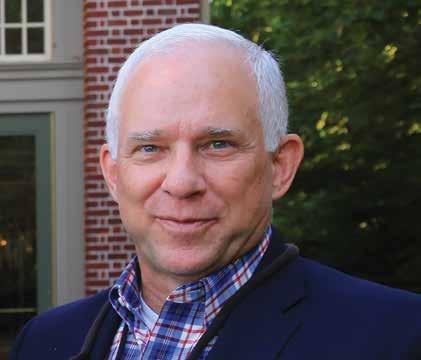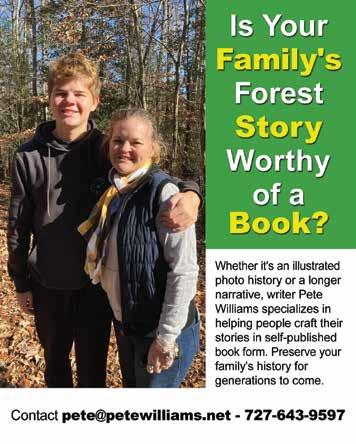
8 minute read
SUCCESSION wit SUCCEEDING
BY DAVID FOIL AND ANDY STONE
When it comes to succession planning with family forest landowners, the key is communication. That’s not always easy with complicated family dynamics, busy schedules, people living far away, and a subject matter that some find confusing.
Advertisement
That’s why David Foil and Andy Stone of Forest Resource Consultants in Macon, Georgia, have developed a program where they meet with multiple generations of a forest landowner family to facilitate the discussion and get the wheels of succession turning. Their goal is not to produce a definitive succession plan, were that even possible in a few sessions, but to get family members thinking about long-term goals, core values, and strategic objectives for the land. That way, they can work toward a term sheet they can take to lawyers, who will draft official documents to guide the family into the next generation and beyond.
Foil, FRC’s President and an FLA board member, and Stone, who serves as FRC’s Director of Family Business Services, will conduct a seminar on succession planning at the 2023 National Conference of Private Forest Landowners in Nashville in June. They spoke recently with Forest Landowner magazine editor Pete Williams about how families can tackle succession planning.
Q: Succession planning for forest landowners seems like a daunting task. Where do you begin?

A: The one important thing, no matter where you are in the process and how much land you have, is to start early with good communication. An education process for family members and future generations will be the key to continuity and improving the probability of success in passing both the land and the legacy to the next generations. It boils down to this background work you do in advance. Some family members are interested, some are not, but there might be some not interested because they don’t understand it. They might be more interested if they know more about the opportunities and benefits. It’s usually a lack of knowledge that makes it overwhelming, and that’s true no matter how much land is involved. Even at the 700 to 800-acre level, it’s hard for some to wrap their arms around the nature of a timberland asset. Studies show that family businesses in transition have a 30 percent probability of successful transfer to the second generation, a 10 to 15 percent probability of successful transfer to the third generation, and less than a 5 percent probability to the fourth generation. A lot of that is due to poor planning and communication.
Q: How do you start the communication process?
A: Start with an annual meeting at the very least, and it’s best to be done at the property. You might break it into an education segment, a tour of the property, and another part where you’re having fun. We did one where the adults were in the education portion, and all the kids were out (supervised) on ATVs. We let them have fun and learn while they were there. That was an activity they won’t forget, going out there and getting muddy, laughing, and learning along the way.
Q: Nobody likes to talk about death and money. How should families broach these sensitive, uncomfortable topics and get the conversation started before it’s too late?
A: You must get everyone in the room and have that conversation. When we work with families, we talk individually with each member first and ask the same questions to find out what they each want before we put them in the same room together. We also set ground rules for the discussion. It helps us as facilitators manage expectations and give them some direction to the conversation.
Q: What feedback do you get?
A: We’ve had situations where one sibling was the primary heir apparent to the decision-making process, and the other siblings had little or no knowledge of the business. In one case, one was vocal about how little the sibling had been told. The sibling felt the father had picked the other sibling to run things. The chosen one thought enough was shared with the other siblings, while the other sibling thought enough wasn’t shared. One sibling just liked getting a check. With multi-sib - ling dynamics, it’s complicated. The key is the controlling party. The first-generation landowner has to take the initiative to start the conversation. It’s hard for the children to force Mom and Dad to talk. We find that if it hasn’t happened by a certain age, it’s likely not going to happen. Then it becomes a process after death, which is generally more difficult.
Q: What other pitfalls and challenges do you see in this situation?
A: People think they can control things from the grave. They have a hard time letting go and trusting the next generation. In a business relationship, there’s a hierarchy where you develop the next generation of leadership, but that doesn’t necessarily happen in families. Instead, you wait your turn and don’t want to let go when you get control. That’s a pitfall people fall into; they’re unwilling to trust and even share information. Some of the family members we’ve worked with didn’t even know the size of the family business. It was big enough to pay attention to, and some family members had no idea what the asset was worth. The controlling person had an idea, but that lack of trust and communication was a big issue.
Q: Even modest landowners tend to hold their land in an S Corp or LLC. Does it make sense to transfer the land to a trust and dissolve the company before death?
A: Families are different, and that dynamic will dictate the answer to the question. Do they enjoy spending time together or not? Is the property a source of family time or just an investment? Why does the matriarch or patriarch own it?

If the children are all on board, you could have an ongoing investment that can be enjoyed, not unlike other real estate assets such as lake houses. On the other hand, it’s easier to divide cash than property, and being proactive about it always helps.
Q: At Forest Resource Consultants, you’ve noted that “a successful transition requires developing a plan between the present and future generation of owners that establishes a common vision for the business as well as a mission statement to guide future decisions.” Simple enough, but how does that translate into succession success?
A: This is where you’re all in a room together and ask the hard questions. What do we want to accomplish with this asset? Is it just investment returns? Family time together? Is it about preparing future generations? We had one patriarch who said he wanted it to be a learning experience for the future generations to see how a business operates. Where does philanthropy fit in? These questions will set the framework and helps unify the family because everyone has input to establish the “why” for your actions. Since everyone has input, you’re beginning to operate on common ground. Everyone’s interest has to be accounted for to develop these values and missions for this asset going forward. Our sessions include several exercises that help the family members determine their core values and personality similarities and differences. This process helps us understand the relationship dynamics and shows the common ground that begins to form the foundation of this mission statement and purpose.
Q: I frequently hear that as a family tree branches out, it becomes more challenging to keep forestland together. The further from the land, the theory goes, the more the heirs are detached and wish to sell. How do you deal with that phenomenon? Do you insist that shares are only sold to other family members?
A: The question becomes, how do you define family? Is it spouses? Just blood relatives? What about stepchildren or adopted children? How about the black sheep of the family? Most feel that shares should only be with family members, but you have to plan for different scenarios and provide for escape provisions. Maybe there’s a family member with a child with health issues. They need money today and don’t feel like they can continue, so they need a reasonable way to get out. There should be a shareholder buyback provision.
Q: What else should a shareholder agreement include?
A: They can be lengthy because there’s much to cover. Some of the critical things with transition include who can own the stock. How do transfers take place? What about distributions? How are they determined and paid, and how often? There are stipulations on how the board is structured and elected. There are operating considerations in a shareholder agreement. A lot it involves what can be done with the shares. You define how the value of the shares is determined annually and the buying and selling of shares. It’s a governance-type document. There could be language prohibiting shares from being used as collateral on loans, which would support the agreement on who owns shares. One of the deliverables of the seminar we’ve developed for family members is a high-level term sheet they can give to an attorney to draft a shareholder agreement.
Q: How much of succession planning is ensuring there are heirs interested in taking over? What if that doesn’t happen? Is the goal then to have professional management and a family board that oversees the company?

A: Not everyone is meant to be the same type of owner. You have owners who work in the business, active owners who mainly contribute at the board/shareholder level, and passive ones who want to make sure they get a check regularly. There’s a place for every one of them. As long as they understand that and it’s laid out before them, they can choose how much they want to be involved. It’s preferable to have the next-generation leadership identifed and perhaps in place before a transition event occurs. If not, you want to determine the best person or option for managing the property.
Q: The LLC seems these days to be the preferred corporate structure. Is that the case, and if so, why?
A: This is best answered by your accountant and attorney based on what best fts your family’s needs. If you were a frst-time investor and buying that frst piece of timberland, you’ll probably decide based on the current tax laws and the advice of your accountant and attorney based on your fnancial situation. The same is true of a timberland ownership structure, whether large or small. That’s for someone who can look at the bigger picture for you. Some corporate structures are more benefcial for the shareholders than others in terms of pass-through of income and expenses. Again, that’s an area for an accountant and attorney.
Q: What are the “guardrails to keep your company from veering off course?”
A: These tie back to your vision. If you want to be a timberland owner, does that allow you to invest in commercial real estate or a tech company? Businesses have strategic plans that outline what line of business they’re in, where they’re headed, and what the limitations are. Do we want to limit investment to timberland and agriculture? Not commercial real estate or residential apartments. It lets the family focus and be involved in developing the guardrails and gives the active managers the boundaries to manage the asset.
Q: Is there anything else to consider?
A: The critical thing to understand is that succession planning is a process and to manage your expectations. You’re not going to get a clearly-defned solution in one family meeting. It will be an intricate process that will be uncomfortable, and that’s okay. Everyone must be respectful and follow the ground rules that everyone’s opinion counts. It will pay huge dividends if you’re willing to share openly and work together. For those willing to put in the hard work, you will have a stronger family unit when you come out on the other side.

